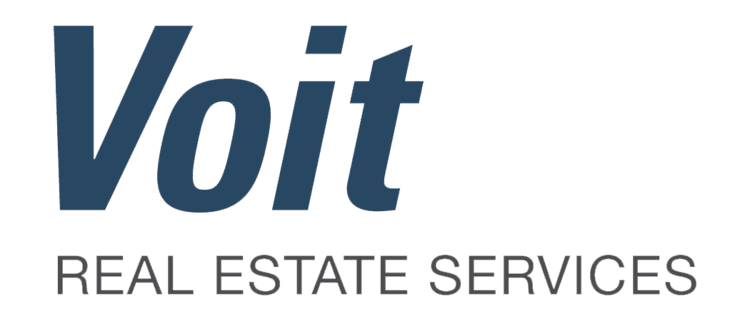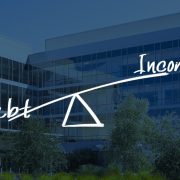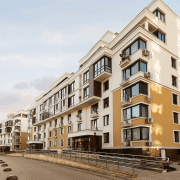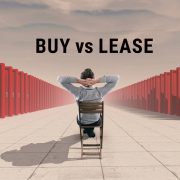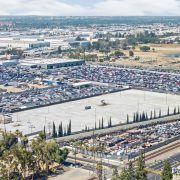The Looming Recession & Industrial Property
Since 2011, owner/user industrial property values in the San Diego region have been on the rise, and have now reached a level that even the most optimistic and experienced professionals never imagined.
Current pricing for industrial buildings is more than double the previous market peak back in 2008, and for those who purchased their buildings back in the 1990s, their properties are worth up to eight times their original purchase price.
Just how did this happen?
The simple answer to that question comes down to two things: cheap money and low supply.
Either one of those market phenomena on its own is powerful enough to set the direction of the market, but together they turbocharged the situation and, many would say, have distorted the balance of supply and demand to a point of unsustainability.
Let’s take a look at each component individually and then look at the implications of putting them together.
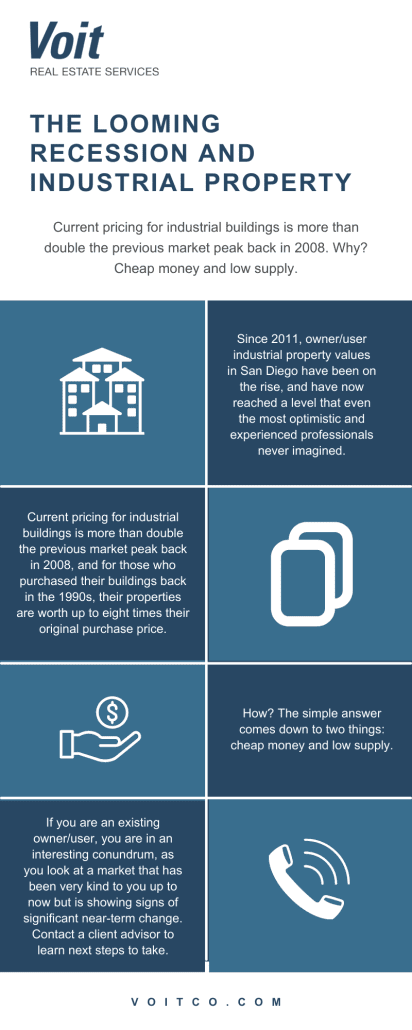
Cheap Money
In response to the financial crisis of 2008, the U.S. Federal Reserve System shifted to a profoundly accommodative monetary policy to stimulate economic growth.
The Fed lowered the Fed Funds Rate (the rate member banks charge each other for overnight loans) to 0% and left it there for years. The Fed Funds Rate influences interest rates across the board, including commercial property mortgages.
So, mortgage rates fell to all-time lows and, until recently, fluctuated between 2.25% and 4% for the past decade.
In addition to keeping rates low, the Fed flooded the market with a new supply of money by buying government bonds and mortgage-backed securities.
The process known as quantitative easing (QE) involves creating new money in a computer to acquire those bonds. The additional supply of capital helped to keep rates low for all kinds of loans, but it also swelled the Fed’s balance sheet to roughly $9 trillion, where it remains today.
Now, profligate government spending of those fabricated dollars, along with other economic factors, have contributed to runaway inflation that has forced the Fed to reverse course and raise the Fed Funds Rate at a rapid pace.
Thus, the era of cheap money has ended abruptly.
For example, the mortgage rate on an SBA 504 loan, the most commonly used loan source for owner/user deals, has risen from 3.21% to 5.19% in just five months.
That’s a 63% increase in the cost of borrowing in less than half a year.
Since owner/users look at controlling occupancy cost as a primary reason for buying, the recent run-up in rates is sending many buyers to the sidelines.
Low Supply
The last significant development of small-to-medium-sized industrial buildings offered for sale to users took place in the late 1980s.
The public improvement district (PID) projects in Central San Diego are good examples. Most of those ground-up projects were financed with dollars sourced through the savings and loan industry, which essentially collapsed in 1989.
The ensuing years-long slump in the commercial property market began to turn the corner in the mid-1990s, and the recovery continued until the 2008 financial crisis shocked the nation.
In roughly 2011, the market began to recover again after a pullback in owner/user prices of 40% or more. Fed stimulus sent mortgage rates to record lows and demand from owner/users soared again.
This time around, however, there was very little new inventory being built and the increase in demand ran headlong into a shortage of existing supply, sending prices through the proverbial roof over the past decade to where they are today.
Implications to Consider
What we have going on now is the weakening of one of the primary factors that have driven the longest bull market in real estate in history: Cheap money. The other, short supply, is still with us and will probably remain so, to a degree, going forward.
Now, if we had excess supply along with more expensive money, a significant market correction would be easy to call. But, we don’t. The vacancy could quadruple and still be at a reasonable level. So, a huge glut of supply is unlikely, even if borrowing money continues to get more expensive.
That said, pricing is bound to be impacted by a reduction in demand caused by higher mortgage rates. Fewer buyers mean less competition for the best buildings. Buildings will take longer to sell, supply will accumulate and the pressure on pricing will likely reverse.
So, if you are an existing owner/user, you are now in an interesting conundrum, as you look at a market that has been very kind to you up to now but is showing signs of significant near-term change.
If you get out now, you are a big winner even if you sell outright and pay your capital gains taxes. Imagine walking away with 10 times your original down payment after taxes!
This is exactly what many owner/users have the opportunity to do, but don’t because they just can’t stand the idea of paying over a third of their gain to Uncle Sam and the Franchise Tax Board. While understandable, it may not be wise given the current state of the economy.
What you decide should be considered carefully based on your unique circumstances:
- Where are you in your life plan?
- How does your real estate figure into your retirement plans?
- Is your business still thriving in your building?
- How has your appetite for risk changed over time?
These are just a few of the important questions you might want to be asking to make sure you are positioned for the best possible outcome. Helping others do just that is what your Voit client advisor is all about.They have the experience and resources to help you make sure that you are right where you need to be to optimize your real estate investment. Get in touch today, then read on to learn more about CRE investment: Is now a good time?
